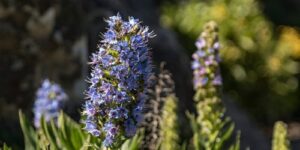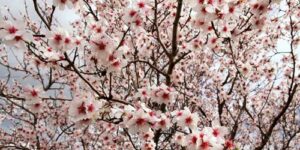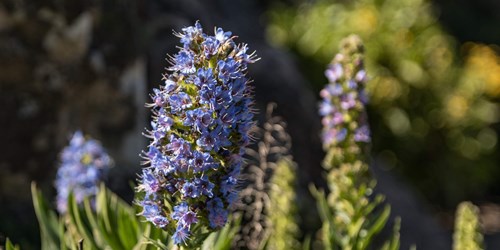THE BEAUTY OF THE BLOSSOMING VEGETATION OF THE ISLAND OF LA GOMERA IN SPRINGTIME
One of the most impressive things that La Gomera has to offer during springtime is the flowering of the tajinaste.
The island of La Gomera, in the Canary Islands archipelago, is a unique place that is characterised by its biodiversity and surprising landscapes.
Among the many natural attractions that our island has to offer, the beauty of the blossoming vegetation in spring, particularly the tajinaste and almond trees, stands out.
The tajinaste: an emblem of La Gomera
One of the most impressive things that La Gomera has to offer during springtime is the flowering of the tajinaste. This plant, which is endemic to the Canary Islands, is known for its imposing inflorescence that can reach up to two metres high.
Its flowering, which takes place between March and May, transforms the island’s landscapes, especially in the higher, mountainous areas.
The tajinaste is a flower that stands out with its spectacular shape and colours, ranging from deep red to pink and purple. Its presence is a symbol of the power of nature and a reminder of the resilience of the Canary Islands flora.
Tajinastes are mainly found in areas such as the Garajonay National Park, a natural paradise declared a World Heritage Site by UNESCO, where they form large patches of colour that contrast with the lush green of the laurel forest.
The tajinaste is also a magnet for pollinating insects, such as bees and butterflies, which contribute to the island’s ecosystem. Thus, the flowering of this shrub is not only a visual feast for the eyes, but also an ecological phenomenon that evidences the interconnection of the species in this privileged natural environment.
The name comes from the Guanche language meaning needle.
The large accumulation of tajinastes forming a “forest” is known as tajinastal.
The factors that determine the varieties of tajinaste are:
- Altitude: Species growing at higher elevations tend to be more robust and with a lower floral prominence.
- Climate and soil: The most common species are found in areas with volcanic soils, for being rich in minerals.

Species and varieties of tajinaste
- Blue or violet tajinaste (Echium acanthocarpum)
- Characteristics: It is a shrub that can reach a height ranging between 1 and 3 metres. It has lanceolate and elongated leaves, of an intense green colour. Its flowers are a striking blue or violet colour.
- Habitat: They grow in laurel forests and moist scrublands on the island of La Gomera.
- Purple or purple-flowered tajinaste (Echium simplex)
- Characteristics: Its flowers are purple, and it is also a tall species with an imposing appearance, although it is usually smaller than the previous ones.
- Habitat: It is mainly found on the islands of La Gomera and El Hierro.
- Pterocephalus tajinaste
- Characteristics: This is another genus within the tajinastes, but its flowers are usually smaller than those of Echium, and the plant is bushier in shape.
- Habitat: It is distributed in several of the Canary Islands, with different varieties depending on the location.
- Red tajinaste (Echium wildpretii)
- Characteristics: This is one of the most emblematic tajinastes. It has bright red flowers that form a very tall spike. It can reach up to 2 metres in height.
- Habitat: It is endemic to the island of Tenerife, especially on the Teide.
- Blue tajinaste (Echium pininana)
- Characteristics: The blue tajinaste is also well known and has blue or purple flowers. Its stem is thick, and it can reach up to 3 metres in height.
- Habitat: It is found on the island of La Palma, mainly in mountain areas.
- Tajinaste de La Palma (Echium virescens)
- Characteristics: Similar to the blue tajinaste, but smaller. It has light blue to violet flowers.
- Habitat: It is endemic to the island of La Palma.
- White tajinaste (Echium aculeatum)
- Characteristics: This species has white or very light-toned flowers, which makes it a little different from the more vibrant typical tajinastes.
- Habitat: It is found on the island of Tenerife, in drier areas.
- Forest tajinaste (Echium leucophaeum)
- Characteristics: Its flowers are in shades of white to pale pink and it is found at higher altitudes.
- Habitat: It is endemic to the island of La Palma.
Almond trees in blossoms: a natural feast for the eyes in La Gomera
Another element that marks the arrival of spring in La Gomera are the almond trees in blossom.
Although these trees are best known for their fruits in autumn, their flowering during the first months of spring, between January and March, is one of the most awaited natural events by the locals and visitors to the island.
The almond tree, with its delicate white and pink flowers, covers the fields and valleys of La Gomera with an indescribable softness and beauty. The blossoming of the almond trees has become one of the island’s most beloved traditions, especially in places like Vallehermoso or the Valle Gran Rey area, where the trees cluster on the slopes of the mountains creating a sea of flowers that attracts both tourists and photographers looking to capture the magic of the season.

The almond blossom also has an important cultural and agricultural value on the island. The fruits of these trees are essential in the local gastronomy, especially in confectionery, where they are used to prepare the traditional sweets from La Gomera.
In spring, the blossoming almond trees are a prelude to the harvest to come in autumn, and at the same time, a symbol of hope and renewal for the island’s inhabitants.
A natural destination like no other: Hotel Jardín Tecina and the blossoming vegetation
From the terraces and gardens of Hotel Jardín Tecina, our guests can enjoy breathtaking views of the blooming landscapes of La Gomera.
This hotel, located in the south of the island, is an ideal place for nature lovers and those looking to escape the hustle and bustle of the city.
In spring, the hotel becomes a privileged refuge where you can admire the flowering of the tajinaste and almond trees, two of the greatest natural treasures of our island.
The trails near the hotel offer endless routes to explore the local flora and enjoy the beautiful flowery scenery. Whether strolling through the Garajonay Natural Park or simply relaxing in the hotel gardens, visitors can immerse themselves in the essence of La Gomera and experience first-hand the splendorous spring of La Gomera.

